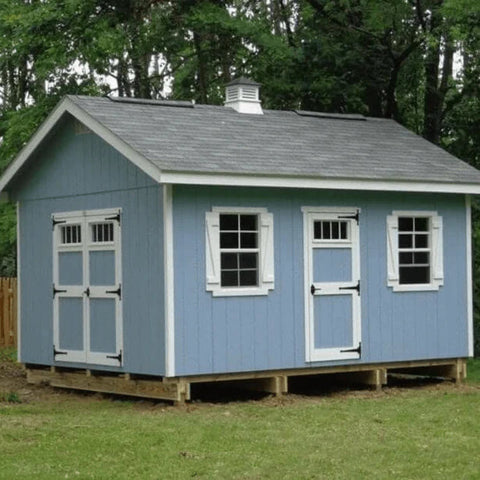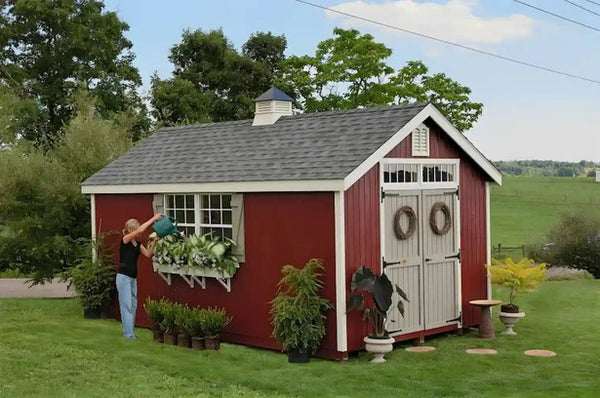1-800-540-905
Info@HomesteadSupplier.com
7am-4pm Pacific Time Mon-Fri
1-800-540-9051
Info@HomesteadSupplier.com
7am-4pm Pacific Time Mon-Fri
1-800-540-905
Info@HomesteadSupplier.com
7am-4pm Pacific Time Mon-Fri
1-800-540-9051
Info@HomesteadSupplier.com
7am-4pm Pacific Time Mon-Fri

At Homestead Supplier, we understand that knowing how much weight a shed floor can hold is essential for both planning and safety.
Shed floors are designed to support a significant amount of weight, but the actual capacity can vary based on factors such as material quality, construction techniques, and the foundation's stability.
By the end of this article, you'll have a clearer understanding of these variables and how to optimize the weight capacity of your shed floor, ensuring that it meets all your storage needs effectively and safely.
What this article covers:The weight capacity of your shed floor isn't just about the floor itself—it's also about the foundation on which it sits. A sturdy foundation is paramount, as it supports everything above it.
From our experience, factors like the material of the floor (be it treated wood or concrete), the quality of the construction, and the condition of the underlying ground all play significant roles.
For example, a well-built timber floor on a solid concrete base can handle considerably more weight than one built on unstable, wet soil.
Calculating the weight capacity of your shed is crucial to ensure that it can safely store all your tools, equipment, and other items without risk of damage. Here's a detailed guide on how to do it:
Start by identifying the material of your shed floor. Materials can vary widely in their strength and durability. Pressure-treated wood is popular for its resistance to rot and pests, and it can bear a substantial weight if properly maintained.
Can you put a shed straight onto concrete? Yes, you can, and concrete is excellent for heavier loads. After putting it to the test, we've found that it provides a robust and immovable base, which is ideal if you're storing heavy machinery or large amounts of supplies.
The way your shed is built plays a significant role in how much weight it can support. Examine the joints and connections between the floor panels. Are they tightly secured?
Also, look at the thickness of the flooring materials. Thicker boards or slabs generally mean better weight distribution and higher load capacity. Good craftsmanship ensures that every part of the shed contributes to its overall strength.
The base and foundation of your shed are just as important as the building materials. Make sure the foundation is level and solid. If it's built on uneven ground or a weak foundation, even the best materials won't prevent sagging or structural failure over time.
Use a spirit level to make sure everything is even. A strong, level base enhances the shed's ability to distribute weight evenly and maintain stability under load. We recommend a robust option such as a shed skid foundation.

After calculating the estimated maximum weight your shed floor can handle, it's wise to add a 25% safety margin.
This extra buffer helps accommodate any additional stress or weight you might not have considered, such as snow accumulation on the roof or the impact from moving heavy items around inside the shed.
According to our research, this safety margin ensures that your shed remains secure and stable, giving you peace of mind.
Ensuring your shed can hold all the necessary weight involves more than just good construction; it also requires strategic enhancements. Here are some detailed tips to help you maximize the weight capacity of your shed:
The choice of materials can significantly impact the durability and load-bearing capacity of your shed. We recommend considering advanced flooring options, which are specifically designed to enhance both durability and weight capacity.
These materials are not only tough but also treated to resist moisture and decay, ensuring they hold up under heavy loads and adverse weather conditions.
If you anticipate storing heavy items or equipment, learning how to protect underside of shed floor by adding support is essential. is essential. Adding extra joists under the flooring can help distribute the weight more evenly.
Consider reinforced framing as well; including cross beams can significantly increase the structural integrity and weight-bearing capacity of your shed floor. This step is crucial for avoiding floor sagging and maintaining the stability of the entire structure.

Reinforcement can take your shed's durability to the next level. Using steel beams or laying an additional layer of thick plywood over the existing floor can greatly enhance its strength.
Steel beams are particularly effective for larger sheds or those that will house heavier items like tractors or large workbenches. Plywood adds an extra layer of protection and helps distribute weight across a broader area, reducing the risk of localized stress points.
Keeping track of your shed's structural load capacity is a proactive way to ensure safety.
Regularly measuring and assessing the load capacity is especially important in regions prone to heavy snowfall or high winds. This ongoing assessment helps you understand if the current structure meets safety standards or if it requires modifications to handle additional stress.
Be ready to make adjustments to your shed's structure as your storage needs evolve or as environmental conditions change. This might mean upgrading materials, adding reinforcement, or even altering the layout inside to better distribute weight.
Keeping an eye on how the shed stands up to its load over time can give you early warning signs if adjustments are needed, thereby preventing potential structural failures and extending the lifespan of your shed.
Understanding and maximizing the weight capacity of your shed floor is crucial for ensuring it meets your storage and operational needs safely and efficiently.
Remember, the key factors that affect this capacity include choosing the right materials, incorporating additional floor support, reinforcing the structure with sturdy materials like steel beams or extra plywood, and regularly assessing the structural load capacity.
Making timely adjustments based on these assessments will further secure the longevity and safety of your shed.
If you're ready to build a shed that stands strong against the elements and heavy use, visit Homestead Supplier today and explore our high-quality shed kits and expert guidance to get started on your project with confidence.

Did our blog meet your needs? You might also find our other guides helpful:
Compare products
{"one"=>"Select 2 or 3 items to compare", "other"=>"{{ count }} of 3 items selected"}
Leave a comment